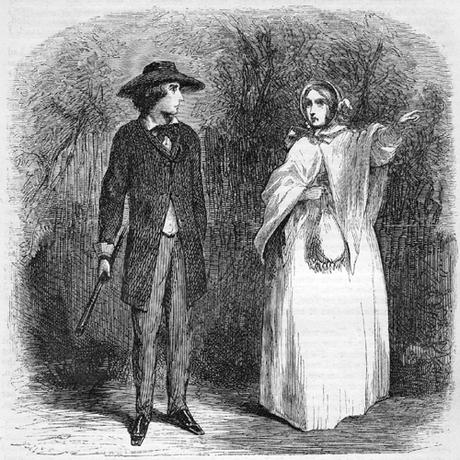
It’s been a while since I read any sensation fiction, and as the weather started to turn increasingly wintry in the evenings over the past couple of weeks, I decided the time had come to pull The Woman in White off the shelf once more and delve in to the wonderful world of Victorian melodrama. Simon over at Stuck in a Book also agreed to read alongside me, and we have discussed our opinions on our podcast, Tea or Books?, which you can listen to here if you feel so inclined. We compared it with Possession by A.S.Byatt, a neo Victorian novel that also has an intriguing mystery at its heart, though of a very different kind, and is another brilliant novel…yet, I digress.
The novel starts with Walter Hartright, who is that perennial Victorian favourite: a poor yet talented artist, down on his luck, walking home across Hampstead Heath on a summer’s evening. He is minding his own business when suddenly, out of the darkness, appears a woman, dressed all in white. She is nervous and awkward, and looks like someone who has suffered much. She asks the way to London, and Walter points her in the right direction. Before long, Walter is stopped by anxious men in a cab, who are looking for a woman dressed in white, just escaped from an asylum. Walter pretends to have no knowledge of her, out of pity for the poor woman, but the mystery of who she is and why she had escaped continues to preoccupy his thoughts. Shortly afterwards he leaves London for Limmeridge House in Cumbria, where he has been engaged as a drawing master to half sisters Laura Fairlie and Marian Halcombe, who are the wards of Laura’s hypochondriac, nervous uncle, Frederick Fairlie, an immensely wealthy aesthete who spends all his time with his art and none with his nieces. Laura Fairlie is extraordinarily beautiful, and she and Walter obviously fall in love immediately. However, the appearance of the woman in white in the village shocks Walter soon after his arrival; not only does she bear an uncanny resemblance to Laura, but she also has a connection to Laura’s mother, and to Limmeridge House. Her name is Anne Catherick, and she is known to be mentally deficient, but she seems to have a morbid obsession with Laura, and with trying to prevent her upcoming marriage. For, Laura, despite being in love with Walter, has long been engaged to Sir Percival Glyde, on the wishes of her deceased father. Much older than her, she does not love him, but feels obliged to marry him out of loyalty to her father. Despite everyone’s misgivings, the marriage must go ahead, and Walter, broken hearted, leaves England for Honduras. However, Sir Percival is not the gentleman he has always made himself out to be, and the woman in white’s warnings prove to reveal the true terror of what he is capable of…
There is much more to the plot of this long, complex and incredibly peopled novel, which is told from a number of different perspectives using the common Victorian device of amassing a collection of ‘genuine papers’ from the main actors in the story. There are some brilliant, vivid characters, including Count Fosco, who is an evil Italian villain who is married to Laura’s aunt and just so happens to be Sir Percival’s best friend, and it’s easy to imagine him strutting around, twirling his moustache and cackling evilly every time he appears on the page. Collins is not a subtle writer, and much of the plot depends on coincidences that to a modern reader appear laughable, but if you sit back and accept everything as read and just allow yourself to be entertained by the many twists and turns and improbable events, then you’ll have a wonderful reading experience. Collins was a master of suspense, and knew just how to keep the reader dangling at the end of every chapter, desperate for more; his careful plotting, using clever moments of occlusion to make us think we are just getting to the answer before snatching it away from us again, keeps the tension consistently high and one’s curiosity constantly at boiling point. I know some find sensation fiction too ridiculous to enjoy, but for me, every moment is a pleasure, and I love the melodrama of it all. I also very much enjoy how Collins very much reflects the contemporary concerns of when he was writing – there is much to think about in this novel when it comes to women’s rights, and when you consider that the 1850s was a decade in which the vulnerability of women due to having no right to retain their own property once married was a key topic of debate, it is clear to see from Collins’ plot that he recognised the need for women to be able to have independence over their affairs to prevent them from being cruelly used by the men who were supposed to be looking after them. I now want to dig deeper into Collins’ back catalogue, as I haven’t read that many of his books – any recommendations for his best ones?
Advertisements &b; &b;